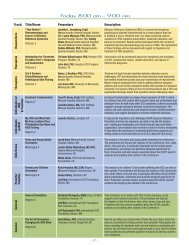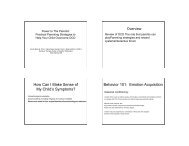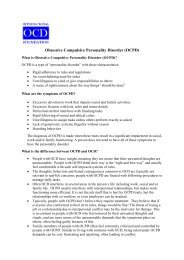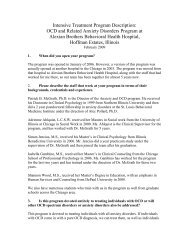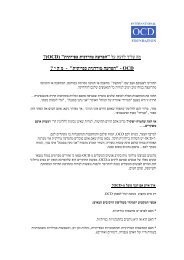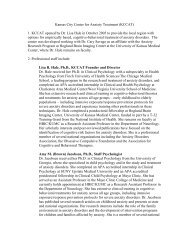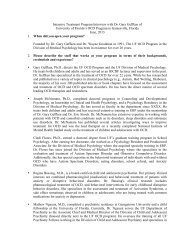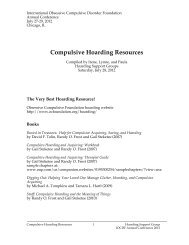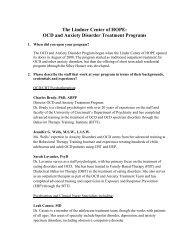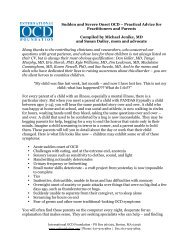perfectionism and - Obsessive-Compulsive Foundation
perfectionism and - Obsessive-Compulsive Foundation
perfectionism and - Obsessive-Compulsive Foundation
Create successful ePaper yourself
Turn your PDF publications into a flip-book with our unique Google optimized e-Paper software.
3. Is regarded as having such an impairment.<br />
The ADAAA did not define “substantially limits” but it did specifically reject the<br />
Supreme Court’s rigid <strong>and</strong> limited definition. A better underst<strong>and</strong>ing of<br />
“substantially limits” will emerge over time.<br />
The ADAAA greatly broadened the definition of “major life activities” to include<br />
“major bodily functions.” As of January 01, 2009, these definitions apply:<br />
Major life activities include, but are not limited to, use of the five senses, caring for<br />
oneself, interaction with others, performing manual tasks, seeing, hearing, eating,<br />
sleeping, walking, st<strong>and</strong>ing, lifting, bending, speaking, breathing, learning, reading,<br />
concentrating, thinking, communicating, <strong>and</strong> working.<br />
FRIDAY<br />
Major Bodily Functions include, but are not limited to, functions of the immune<br />
system, normal cell growth, digestive, bowel, bladder, neurological, brain,<br />
respiratory, circulatory, endocrine, <strong>and</strong> reproductive functions.<br />
The ADAAA redefines <strong>and</strong> exp<strong>and</strong>s coverage under the “regarded as” prong of the<br />
definition of “disability.” To satisfy the “regarded as” st<strong>and</strong>ard an individual need<br />
only show that he or she was subjected to an action prohibited under the statute<br />
(e.g., termination; failure to hire) because of an actual or perceived impairment. It is<br />
no longer necessary that the impairment be perceived by the employer to limit or<br />
“substantially limit” a major life activity.<br />
Before the ADAAA, “mitigation measures” that increase the functioning of a person<br />
with an impairment were considered in determining whether a person met the<br />
definition of “person with a disability.” In other words, the determination of<br />
whether a person was substantially limited was made after the person received the<br />
benefit of the mitigating measure. For example, if a person with diabetes controlled<br />
his or her diabetes with Insulin, that person may not have been considered as having<br />
an impairment, because the Insulin removed the limitations which were present<br />
before the medication.<br />
Now, after the ADAAA, the determination must be made regardless of the<br />
mitigating measures; that is, before those measures are used or applied.<br />
Additional protections of the ADA<br />
Under the ADA it is unlawful to retaliate against an individual for opposing<br />
disability discrimination in employment, or for filing a discrimination charge,<br />
testifying, or participating in any way in an investigation, proceeding, or litigation<br />
under the ADA.<br />
The ADA also protects other individuals in certain circumstances, including family<br />
members who are associated with a person with a disability.<br />
ADA as Amended<br />
Ask an Attorney!<br />
Marilynn Mika Spencer IOCDF Annual Conference 2013<br />
-74-





